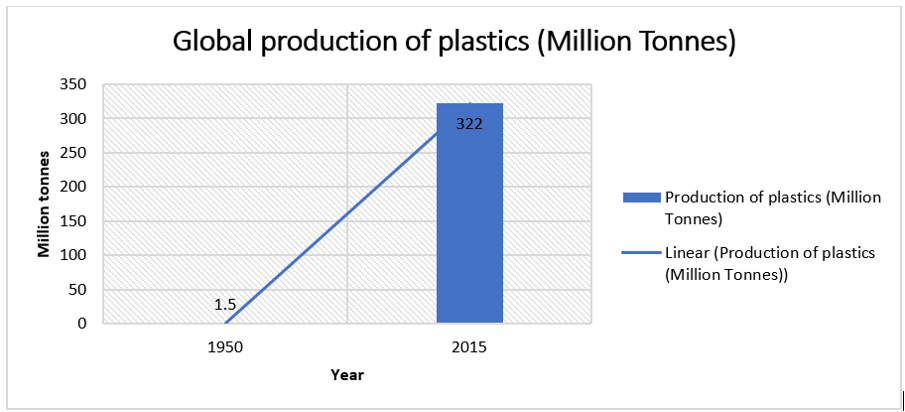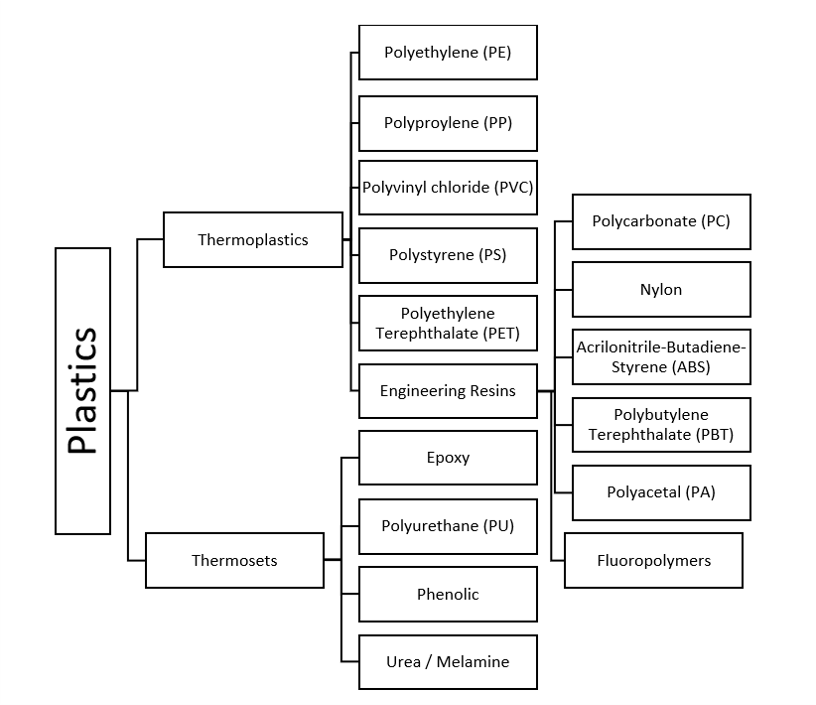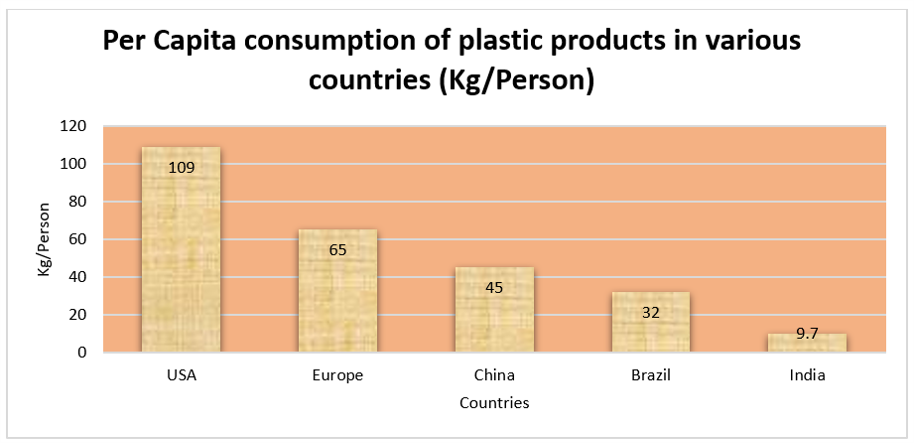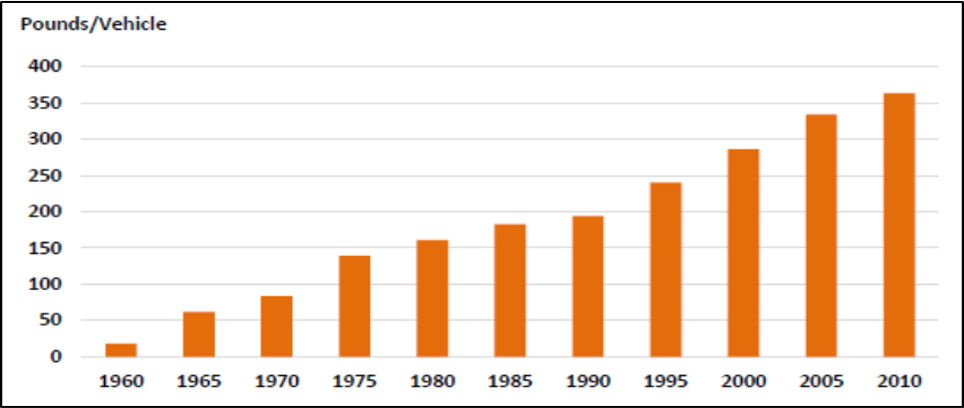Plastic Trends in USA (Specific Use in Automotive Sector): Plastics are an important material that has become part of our daily life. Plastics production globally has increased from 1.5 million tonne in 1950 to 322 million tonne in 2015, in a period of 65 years (Fig. 1), and is expected to increase to two times in the next 20 years (Plastics Europe, 2016). The production growth rate from 2014 to 2015 has been 3.4 percent. The compound annual growth rate during the period 1950 -2015 is about 8.6 percent. Plastics are growing world over with new materials, new processes, new machineries new markets and new manpower. The trend throughout the world is to replace a large number of materials used earlier by plastic materials. The number of applications of plastics in our daily life is increasing every day. More than 90% plastics are derived from fossil feedstocks and has a significant impact on the environment. It is estimated that all the plastics is equivalent to about 6% of the global oil consumption or to the oil consumption of the global aviation sector (WEF, 2016). If the current rate of usage of plastics continues, the plastics sector will account for 20% of total oil consumption in 2050.



Plastics are increasingly used in many sectors of economy such as packaging, construction, automotive, transportation, healthcare and electronics. According to ATKearney (2012), plastics now roughly makes up 15% of a car by weight and about 50% of the Boeing Dreamliner (Anrady and Neal, 2009). Anrady and Neal (2009) argue that plastics have brought in extensive economic benefits to these sectors due to low cost, versality, durability and high strength-to-weight ratio.
Plastic Resins
American Chemistry Council Economic & Statistics (ACCE & SD) (2013) defines plastics resins as synthetic, long-chain compounds derived from one or more monomers such as ethylene, vinyl chloride, styrene, propylene etc. Monomers can be obtained from oil, natural gas, and from bio-based sources. Plastic resins are raw materials for making finished plastic products. They can be molded and can be given any shape and specific characteristics. The classification of plastics is shown in Fig. 2.



Source: ACCE&SD (2013)
Thermoplastics
Thermoplastics are the polymers and have unique characteristics. When heated, the thermoplastics soften and get hardened when cooled. These resins can be re-softened to the original condition by heating again. These products can be recycled
The main plastics resins include PET, HDPE, PVC, LDPE, PP, PS, and EPS. Plastics resin are used in a large number of applications in daily life which are presented in Table 1 (ACCE & SD, 2013).
Table 1: Plastic resins and their applications
| S. No. | Plastic Resin | Applications in packaging |
| 1 | PET | Bottles for water and soft drink, domes for salad, trays for biscuits, salad dressing and containers for peanut butter |
| 2 | HDPE | Bottle for milk, freezer bags, dip tubs, crinkly shopping bags, ice cream containers, bottles for juice bottles for shampoo, chemical and detergent. |
| 3 | PVC | Containers for cosmetics, commercial cling wrap |
| 4 | LDPE | Squeeze bottles, cling wrap, shrink wrap, rubbish bags |
| 5 | PP | Dishes for use in microwave, ice cream tubs, bags for potato chips , and dip tubs |
| 6 | PS | Cases for CD, cups for water coolers, plastic cutlery, imitation “crystal glassware”, video cases |
| 7 | EPS | Cups for foamed polystyrene hot drink, hamburger take-away clamshells, foamed meat trays, protective packaging for fragile items. |
| 8 | Others | Bottles for water cooler, flexible films, multi-material packaging |
Thermosets
These are polymers, which unlike thermoplastics, cannot be softened in their final stage by heat and hardened by cooling in their finished goods and therefore cannot be recycled. Buildings and construction are the main areas of use thermosets. They have extensively been used since long time back in laminates, wiring devices, plywood and other structural panels, carpet, refrigerator insulation, buttons and knobs, flooring, panels, tanks, boat hulls, and shower-stalls.
Engineering plastics
Engineering plastics, a part of the thermoplastic, are parts and parcels of today’s life. They are characterized with high mechanical, electrical, and chemical properties. Acetal, fluoropolymer, polycarbonate, polyphenylene sulfide and other resins are part of engineering plastics. Engineering plastics are substitute of metals and extensively replacing metals. These resins are used in valves, faucets, zippers, wire and cable jacketing, non-stick coatings, microwave cookware, appliance and electronics housings, hair dryers, bearings, gears, and many other products. Also, Read: Utility patent drawings
USA Plastic Industry Scenario
United States is the country with the highest per capita consumption (109 Kg/person) of plastics in the world (FICCI, 2014). Per capita consumption of plastics in Europe in the same period is 65 Kg/person, and in China 45 Kg/person (Fig. 3) (FICCI, 2014).



Fig. 3: Per Capita consumption of plastic products in various countries.
Plastics industry can be viewed in four categories:
- Plastics manufacturing.
- Plastics wholesale trade
- Captive Plastic products manufacturing
- Plastic upstream
The first three categories form the plastics industry. Captive plastic products are plastic processing activities located in manufacturing units, such as assembly shops of automobiles and milk bottling plants, which are not classified by the government as part of the plastics industry. Table 2 shows the size of the four elements of the plastics industry (Plastics, 2016).
| Table 2: Total picture of the USA plastics industry in 2015 | ||||
| Plastic industry components | No. of Establishments | Employees (Thousands) | Industry shipment value (Million$) | |
| Plastics Manufacturing | Plastics materials and resins (NAICS 325211) | 1,138.00 | 67.2 | 90,169.20 |
| Plastics products (NAICS 325991 and 3261) | 11,030 | 616.4 | 205,920.70 | |
| Plastics working machinery (NAICS 3332201) | 431 | 11.5 | 3895.6 | |
| Molds for plastics (NAICS 33351105) | 694 | 16 | 2752.2 | |
| Plastics Manufacturing Total | 13,293 | 711.1 | 302,727.60 | |
| Plastics Wholesale Trade | Wholesale trade for plastics materials, forms and shapes (NAICS 424610). | 3,375 | 33.9 | 45,636.10 |
| Government-documented Plastics Industry | 16,668 | 7,451 | 348,363.10 | |
| Captive Plastic Products | Captive Plastic Products | #N.A. | 209 | 70,004.50 |
| Plastics Industry | #N.A. | 954 | 418,368.20 | |
| Upstream impacts | #N.A. | 791.2 | 153,120.60 | |
| Full Impact | #N.A. | 1,745.20 | 571,488.80 | |
Table 2 shows that the US plastics industry comprised 16,668 manufacturing units employing 745,000 persons and handled shipments of $348 billion in 2015. In addition to this there were units which were producing captive plastic products or supplying goods and services to the plastic industry. Considering the captive units within the plastic industry, the industry employed a total workforce of 954,000 employees. An additional 791,000 people were employed by the upstream industries, the suppliers of the plastic industry. The total impact of the plastic industry in USA was to employ 1.75 million people. Similarly, $153 billion additional shipment was generated by the upstream suppliers, increasing the total shipment impact of the plastic industry to $571 billion. Table 2 does not include the impact of the downstream industry that use plastics. Also, Read: Design patent drawings
According to the report of Plastics Industry Association (Plastics, 2016), plastics industry in USA in the last 35 years (1980-2015), fared well in terms of industry employment, real shipments and real value added in comparison of growth rate between plastic manufacturing and that of all manufacturing in USA (Table 3).
Table 3: Higher growth rate of plastics manufacturing in comparison to the growth rate of all manufacturing during the period of 1980-2015 in the USA



Source: Plastics (2016)
Some of the highlights of the plastics industry in USS (Plastics, 2016) are:
- The employment growth rate in case of plastic industry was 0.3 percent per year during the period 1980-2015 as against a fall of employment rate by (-)1.2 percent in all of USA manufacturing industries during the same period.
- The plastic industry in USA is large, registering 954,000 jobs and $418.4 billion in shipments during 2015. These figures are much more impressive by taking into consideration the suppliers to the plastics industry, jobs increased to 1.75 million and total shipments increased to $571.5 billion.
- The plastic products portion of the plastics industry ranked eighth largest U.S. industry in 2014.
- The plastic materials and synthetics portion of the plastics industry (including rubber and fiber) was the sixteenth largest industry in 2014.
- The plastics industry is showing long-term growth trend after recovery from the recession.
- Manufacturing is the main customer for plastics. Majority of plastic materials and products are purchased by manufacturing companies, who process these materials and products further before they reach to their end user.
- The real shipments growth rate minus the employment growth rate (2.4 – 0.3)—productivity in plastics manufacturing grew 2.1 percent per year from 1980 to 2015, which is slightly better than the 2.0 percent per year productivity growth for manufacturing as a whole.
- Low inflation, cheap natural gas/gas liquids and a growing economy have turned things around.
- Lower world oil prices recently improved the competitive positions of overseas plastics producers, but the U.S. continues to be competitively advantaged due to cheap shale gas.
- The plastic industry in USA is spread in all the 50 states of USA. Texas is having the largest number of the employee.
Challenges faced by USA Automotive Industry
The US automotive industry has been under tremendous pressure during the year 2008 due to global recession. Many automotive manufacturers faced difficult situations and were forced into closure, liquidation, and staff retrenchment throughout the company (OTM, 2011). The signs of recovery were seen with highest production in 2013, the highest in the past 6 years (Mutikani, 2013). Industry faced number of challenges during the period such as to increase fuel efficiency to meet the environmental regulations and tough standards, to satisfy customers with high performance and to increase value to the customers. Environmental Protection Agency (EPA) and Department of transportation set targets to reduce emission level to 163 grams of CO2 per mile in the model year 2025, which is equivalent to 54.5 miles per gallon (mpg) (EPA and DOT, 2017)
Plastics and polymer composites in the automotive industry in the United States
The automotive producers and part suppliers started looking for opportunities to reduce the weight of the vehicles, and the cost of the vehicles and still maintain or to improve the performance, quality, and safety of the vehicles. Also, Read: Patentability Searches
According to ACCE&SD (2013), light vehicles in the US consume roughly 18% of total US energy as gasoline. The substantial consumption of energy in light vehicles calls for improved vehicle design for reducing weight of the vehicles. High fuel efficiency, reduction of emission and low cost of the vehicle for the motorists are priority areas in US. Many plastic components are 50% lighter in weight than the components made of up of other materials. ACCE&SD (2013) points out that the use of plastic components can reduce the weight up to 30%. An average light vehicle contains 360 pounds of plastics and composites which is 9.5 percent of vehicle weight. About a decade back the weight of plastics used to be 307 pounds only, which was 7.8 percent weight of the vehicle. This shows that the use of plastics and composites in vehicle has increased by 21.8 percent that has enabled the automotive manufacturers to comply with the strict Car Fuel Economy standards. Fig. 3 shows the weight of the plastic resin and composites in light vehicles during the period 1960 to 2010 (ACC, 2014). The lower weight of the cars helps in reducing the emission of the CO2, SO2, nitrous oxides and particulate matters.



Fig. 3: Weight of the plastic resin and composites in light vehicles
ATKearney (2012), based on its analysis for the period 1970 – 2010, has given the percentage share of plastics and other materials used in vehicles in the US (Table 4). The percentage weight of plastics in the vehicle was only 6% in 1970, which increased to 9% in 1980, 13% in 1990, 14% in 2000, and 16% in 2010 and is likely to go up to 18% in the year 2020. It is also observed from the data in Table 4 that during the period 1970 to 2010, the average weight of the vehicles in US increased from 1,100 Kg in 1970 to 1,400 Kg in 2010 but afterward reduced gradually and is expected to be 1,100 Kg only in the year 2000. Weight of the rubber and other materials is also taking a higher share in the average weight of the vehicles in US during the period 1970 to 2010 and is expected to rise to a level of 7% and 20% respectively in the year 2020. At the same time, the percentage weight of metals in vehicles has reduced from 79% in 1970 to only 61% in the year 2010 and is expected to further reduce to 55% in 2020. The gain in percentage in the case of plastics is due to a reduction in the percentage use of metals. Also, Read: Patent Invalidity Search
Table 4: Plastics and other materials usage trend as a percentage of total vehicle weight
| S. No. | Year | Average vehicle weight (Kg) | % weight of materials in the average weight of vehicle | |||
| Plastics | Rubber | Metals | Other | |||
| 1 | 1970 | 1,100 | 6 | 2 | 79 | 14 |
| 2 | 1980 | 1,180 | 9 | 2 | 76 | 14 |
| 3 | 1990 | 1,260 | 13 | 5 | 65 | 17 |
| 4 | 2000 | 1,340 | 14 | 6 | 63 | 18 |
| 5 | 2010 | 1,400 | 16 | 6 | 61 | 18 |
| 6 | 2020 | 1,100 | 18 | 7 | 55 | 20 |
| Source: A.T. Kearney (2012) | ||||||
From the above it is observed that the use of plastics and polymer composites is the natural choice for the automotive industry. These materials have already made contributions as light weight and value producing materials. In addition to these features, plastics and polymer composites contribute to aesthetics, aerodynamic design, and value in many interior and exterior applications. Fiber-reinforced composites are now increasingly used in structural applications such as body-in-white and chassis components. They are able to reduce the overall weight of the vehicles and yet maintaining or even improving the safety and performance(ACC,2014).
Use of different variety of plastics in cars
Different types and grades of plastics are used to meet different performance requirements in vehicles such as appearance, rigidity, resistance, weight and cost. Table 5 shows the types of plastics used in different parts of the cars (ATKearney, 2012). Plastic consumption in cars varies from region to region and also from one producer to another.
Table 5: Types of plastics used for different parts in the car
| S. No. | Plastics used | Parts of Car |
| 1 | Polypropylene (PP) | Dashboards, wheel covers, some engine parts. |
| 2 | Polyurethane (PUR) | Seats |
| 3 | Polyethylene (PE) | Carpets |
| 4 | Polyamides (PA) | Parts that to be heat resistant and chemical-resistant. |
| 5 | Mass volume plastics – acrylonitrile butadiene styrene (ABS), PP, PUR, and nylon | 70% of the plastics used in a car. |
| 6 | Composites and higher-end plastics | Rest of the plastics in the car |
Source: ATKEARNEY (2012)
Carbon-fiber-reinforced composites
According to Sedgwick (2011), Carbon-fiber-reinforced composites are 50% lighter than conventional steel and 30% lighter than aluminum, and therefore more and more automotive manufacturers and parts suppliers are adopting these composites. Stevens, Tim (2013) reports that the electricity-driven car of BMW, the i3, is using carbon-fiber-reinforced composites in the body structure. Du-Pont (2012) is going from metals to plastics in transmissions and drive lines. According to DuPont (2012), computer simulations have indicated that polymer composite driveshafts can be manufactured at half the weight and at half the cost of aluminum driveshafts. Also, Read: Freedom-to-operate searches
ATKearney (2012) points out several advantages in the use of fiber-reinforced plastics composites in terms of improved technical performance that are discussed below:
- Weight: 25-35 percent lighter in weight than steel parts of equal strength.
- Manufacturing: Faster to assemble due to fewer parts being required. The manufacturing costs and complexity are low and help in speeding the design and process when a new model is introduced.
- Tooling Cost: The tooling cost is about 40% of the steel stamping, a big advantage.
- Resistance to damage: Fiber-reinforced plastics have superior ding and dent in comparison to aluminum and steel panels.
- Corrosion resistance: Offers better corrosion resistance than most of the materials.
- Internal damping: Offers less noise, less vibrations, and less harshness.
- Design: Fiber-reinforced plastic composites offer more versatile designs. Its molding offers geometric details, shape-complexities, and a depth-of-draw range that are not available with metal stampings. In some areas fiber-reinforced plastics composites permits manufacturing of the vehicle parts which are not feasible with other materials.
High energy absorption qualities of plastics
The plastics and polymer composites have high energy absorption qualities. They can be made to meet the strict safety standards such as to withstand the collusions and accidents. Polymer composites are the materials of choice in motor sports and aerospace industries. The high strength absorption and energy absorption characteristics improve crash safety by improving the strength of the vehicle and offers safety to the passengers.
Innovative moves of the Automotive Manufacturers
Automotive manufacturers in USA are under continuous pressure of CAFÉ requirements even though the number of trucks on the roads have been rising for the past few years. CAFÉ’s rising fuel efficiency standards “54.5 miles per gallon by 2025” is in focus of the industry although there are different requirements for the cars and the trucks. The goal for the cars in 2015 was 39 miles per gallon while the target for the full-size truck was 23.5 mpg (PNR, 2016). It will be rising to 49 mpg for the compact cars and 25 mpg for trucks. A compact SUV will have a target of 39 mpg. Car manufacturers will find it difficult to reach these targets. Plastics will play the key role to meet these targets. Different car manufacturers started looking into new innovating ideas in restructuring their designs.
Nissan’s initiative
Nissan collaborated with supplier Magna International Inc. to try out a new plan leaving behind the use of its own in-house production of steel stampings for making the rear liftgate (PNR, 2016). Magna, 12 years ago, has proposed to use thermoplastics polyolefin for making a complete tailgate module in place of steel for bulk of the parts. The Aurora, Ontario based supplier supplied that liftgate to production line. TPO liftgate was also made 30 percent lighter than steel and still a saving 10% in the fuel consumption. This a clear example of plastics playing part in reducing the weight of the vehicle as well as saving in fuel.
The Institute for Advanced Composites Manufacturing Innovation
The White House announced a federal research effort, the Institute for Advanced Composites Manufacturing Innovation, to coordinate the research efforts by the industry, government and universities to research on fiber-reinforced plastics for the development of light weight composites for applications in automotive industry (PNR, 2016). This initiative was designed to find out ways to move the carbon fiber out of the niche vehicles such as sports cars as well as into more day-to-day cars and trucks.
Ford’s contribution in light-weight car movement
Ford unfolded its increasing interest in carbon fiber during 2015 North American Auto Show stating that it has been using carbon fiber extensively in its small volume GT super car (PNR, 2016). As a new initiative, the GT car with carbon fiber was in small volume but is expected to come with full carbon body structure and body panels showing that the auto industry can adopt new things if the objective is reduction in weight of the car. Also, Read: Patent Landscape Search
The GM’s efforts
GM has used sheet molded compound body panel using hollow glass microspheres from its supplier 3M Co. rather than using a more traditional calcium carbonate reinforcement. The part, molded by Continental Structural Plastics, was 43 percent lighter than conventional SMC and 28 percent over mid-density grades of advanced SMC composites.
SPE also honored Audi AG for its use of a glass fiber reinforced epoxy in a coil spring, replacing what has traditionally been a metal part. Body panels also may be getting more attention from France’s Cie. Plastic Omnium, signed a memorandum of understanding to acquire the bulk of Faurecia SA’s exterior plastics operations, which includes bumpers and frontend modules. Plastic Omnium allows it to emerge as one of the 25 largest auto suppliers in the world, one specifically focused on expanding the use of plastics in lightweight body applications.
Under the hood applications
Plastics is also used around the engine to make the internal combustion engines to work more efficiently. Automotive industry has found that additional fuel savings are possible through the gasoline engines. This may come from the use of plastics and reducing the weight of the vehicle. The reduction in the weight will be by using more plastics than metal such as using plastics in an oil pan, cylinder heads or cam covers.
A[JPS1] mild hybrid card, a combination of both plastic and metal, is gaining importance due to its stop-start technology, which stops the engine when they are idling at lights or stop signs, then automatically restart once the driver put the pressure on the accelerators. In this way, the gas use is cut without any impact on the driver. The system uses a battery to keep everything running when the engine is shut off and restarts without any problem. The battery is enclosed in plastics for stop-start. It is estimated that 40 percent of the vehicles in US will be sold with this arrangement by the year 2020 (PNR, 2016).
Another important application of the plastics is the use of high heat and chemical resistant nylon in turbo chargers which enables the smaller engines to meet the high-performance demands. Ford has adopted this concept of turbo charger boosting that allows use of V6 engine in place of V8 engines and using less fuel (PNR, 2016).
DuPont has collaborated with Ford for the key parts of the Turbo system to develop an injection molded resonator within the blow molded ducts which eliminated a high-pitched whining sound. Nylon and other engineering resins have been used in this application.
Natural Fibers
Several automakers are keen to design parts using bio-based or renewable materials wherein natural fibers are incorporated into plastics. Suppliers are building capacity to produce the natural fiber products with design flexibility and weight reduction potential. In addition to the weight reduction, natural fibers composites can offer the advantages of recyclability or less wear on tooling.
New generation of materials
Suppliers are working on developing new materials and new fillers to achieve weight savings and at the same time meeting the design and performance needs of the Original Equipment Manufacturers (OEMs). Material suppliers have introduced new grades of high temperature-capable resins intended for use in automotive air ducts and other under-the-hood components. Reducing weight in one part of the vehicle enables other parts of the vehicle to be downsized resulting in further weight reduction. Also, Read: Freedom to Operate Search Sample Report
Underbody components prone to chipping and exposed to road salt and debris need resins with chemical resistance characteristics. General Motors Co. (PNR, 2016), developed a strut mount for its Cadillac CT6 made with high-performance glass fiber-reinforced nylon, able to withstand rain, road salt, debris and vibration while also providing weight reduction and a smoother ride.
The smartphone screen layered with a thermoplastic adhesive is the choice of Ford for its new GT. Plastic industry is to come up with the next strategy of automotive light weighing.
Conclusion
The price of the resins is linked to the price of the crude oil. The availability of shale gas in US has change the scenario of the plastic industry of US, which has become more competitive. Plastics reinforced by glass or fiberglass has increased the weight of plastics for about 360 pounds in the total weight of the average US lightweight car. Today, plastic is used in parts such as instrument panels, interior trim and bumpers. Polypropylene is used in about one third of the parts, carbon fiber is becoming the material of choice for body panels, hoods and trunk lids. Heavier iron and steel parts can be replaced by light weight advanced composites and other plastics to enhance vehicle fuel economy. The indirect benefits of the light weight of vehicles enables smaller power plants and energy storage systems, as well as secondary weight reduction in load bearing structures.
ACC. 2014. Plastics and Polymer Composites Technology Roadmap for Automotive Markets. A publication of American Chemistry Council (ACC). 1-64.
ACCE&SD. 2013. Plastics Resins in United States. A publication of American Chemistry Council. Economics and Statistics Department for American Chemistry Council Plastic Division. 1-36.
Anrady, A. and Neal. M. 2009. Applications and societal benefits of plastics. Philosophical Transactions of the Royal Society B.
ATKearney. 2012. Plastics: The Future for Automakers and Chemical Companies. A publication of A. T. Kearney Korea LLC. 1-8.
DuPont (2012). DuPont-Leading the metals-to-plastics revolution in transmissions and driveline. Autofocus. 18, http://www2. dupont.com/Plastics/en_US/Knowledge_Center/autofocus/issue18/autofocus_issue18_02.html.
EPA and DOT. 2017. 2017 and Later Model Year Light-Duty Vehicle Greenhouse Gas Emissions and Corporate Average Fuel Economy Standards; Final Rule, 77 Fed. Reg. 62623 (Oct. 15, 2012). A publication of Environmental Protection Agency and Department of Transportation.
FICCI. 2014. Potential of Plastics in Northern India with special focus on plasticulture Group and food processing: A report prepared by Tata Strategic Management for FICCI.
Mutikani, Lucia. 2013. Manufacturing sector regaining some momentum. Reuters, September 16, 2013, http://www.reuters.com/article/2013/09/16/us-usa-economy-output-idUSBRE98F0DV20130916.
Office of Transportation and Machinery (OTM) (2011). On the Road: U.S. Automotive Parts Industry Annual Assessment. A publication of U.S. Department of Commerce.
Plastics. 2016. The future of American Manufacturing will be built with plastics. Publication of Plastics Industries Association, USA. 1-12.
Plastics Europe. 2016. Global Plastics Production 1950-2015. A publication of Association of Plastics, Europe. 1-8.
PNR. 2016.Plastics in Automotives. Plastic News Research, Jan.2016. 1-102.
Sedgwick, David. 2011. New techniques cut cost of carbon fiber. Autoweek (July 2011), http://www.autoweek.com/article/20110711/CARNEWS/110719991.
Stevens, Tim. 2013. 2014 BMW i3 EV drive review. Autoweek (October 2013), http://www.autoweek.com/article/20131015/carreviews/131019872#.
WEF. 2016. The New Plastics Economy. A publication of World Economic Forum. 1-36.
